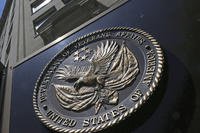
[EDITOR'S NOTE: For all you international arms deal buffs, I thought I'd include this post from our friends at Aviation Week who provide Military.com with a story per day to titillate DT readers. Robert Wall (who wrote this story) is an old friend of mine from the defense industry coverage beat and one of the best sourced reporters in the biz.]
This article first appeared in Aviation Week & Space Technology.
Swiss and Brazilian fighter competitions are edging closer to a decision, but industry officials fear both projects may unravel this year.
The Brazilian air force says it concluded its technical review, although that document has not yet been submitted to the defense ministry.
Timing on the Swiss program is also up in the air, although the aircraft evaluation is complete. A first draft of the nation's strategic defense review is due in the spring; however, Defense Minister Ueli Maurer recommends that the program to partially replace 54 F-5s be postponed so that the money can be spent on more urgent defense needs. Maurer reiterated the call to hold off on the fighter plan in his year-end review.
The government so far has been reluctant to embrace Maurer's view. Another unknown is whether a decision on the project comes in the spring, once the strategic review's first draft is finished, or whether politicians will wait until the fall when the final document is ready, says a Swiss defense ministry official. A type selection will be announced only after a project go-ahead is given.
Operational effectiveness in air-to-air combat is the dominant criterion in Switzerland's evaluation, but a number of other elements are playing roles. For example, industrial participation and military cooperation constitute 25% of the overall grade.
Noise footprint also will be a factor and could be critical due to Switzerland's constrained airspace. The government scrutinized all three candidates -- the Eurofighter Typhoon, Saab Gripen and Dassault Rafale -- during their trials. The results were mixed, but clearly all would be louder than the F-5.
The Typhoon -- flying at an altitude of 305 meters (1,000 ft.) with afterburner -- had the highest peak noise level (114 dB.), followed by the Rafale and Gripen; the F-5 benchmark is 106 dB., according to a Swiss government document. The order among the three candidates was the same when operating at maximum power, with Typhoon at 110 dB., Rafale at 108 dB. and Gripen at 105 dB. A 10-dB. difference represents a doubling of the noise footprint, the Swiss say.
However, peak noise is only one part of the evaluation process. The Swiss documents indicate that noise footprint varied considerably. In light configuration, with the aircraft accelerating from maximum speed to afterburner, the Rafale's nose-on footprint was the largest. How the variance in performance between different mission profiles will be assessed is not clear.
Read the rest of this story, see what generals are psyched about in Afghanistan, hang with the 'AirMule' and check out the vid of the JSF in STOVL mode from our friends at Aviation Week, exclusively on Military.com.
-- Christian








